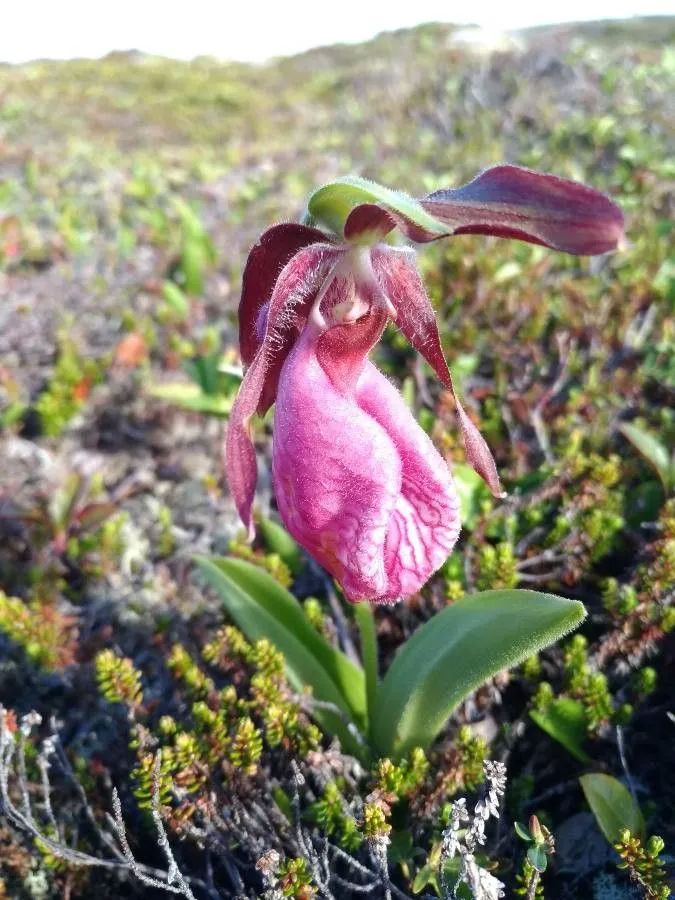
Author: Aiton
Bibliography: Hort. Kew. 3: 303 (1789)
Year: 1789
Status: accepted
Rank: species
Genus: Cypripedium
Vegetable: False
Observations: C. & E. Canada to NC. & E. U.S.A.
The Pink Lady’s-Slipper, scientifically known as Cypripedium acaule, is a striking and distinctive member of the Orchidaceae family. First documented in 1789, this captivating orchid species has garnered attention for its unique beauty and intriguing morphology.
Native to the regions of central and eastern Canada as well as the northeastern United States, the Pink Lady’s-Slipper thrives in its natural habitat, which ranges as far south as North Carolina. This orchid typically favors shaded woodland environments with acidic soils, often under the canopy of pine and mixed hardwood forests.
The Pink Lady’s-Slipper is renowned for its showy, pink flowers, which emerge in late spring to early summer. The bloom features a distinctive pouch-shaped labellum that resembles a delicate slipper, thus giving the flower its common name. This enchanting flower not only boasts aesthetic appeal but also plays a specialized role in its ecosystem by engaging in a unique pollination strategy.
Bees are the primary pollinators of Pink Lady’s-Slippers. Attracted by the vibrant color of the flower, bees enter the pouch but find it challenging to exit due to the inward-pointing hairs. This design ensures that the bees come into contact with the flower’s reproductive structures, thereby facilitating cross-pollination when they visit another flower.
An important aspect of the Pink Lady’s-Slipper’s life cycle is its symbiotic relationship with fungi. The seeds of this orchid lack stored nutrients and rely on specific mycorrhizal fungi to supply the necessary nutrients for germination and growth. This delicate dependency highlights the intricate balance within ecosystems where these orchids are found.
Despite its alluring beauty, the Pink Lady’s-Slipper is not without challenges. Habitat loss and environmental changes pose significant threats to its populations. Additionally, the collection of wild specimens has further stressed the species. Consequently, conservation efforts are crucial to preserve this exquisite orchid and its natural habitat.
In summary, Cypripedium acaule, or the Pink Lady’s-Slipper, is a remarkable orchid species admired for its stunning flowers and intricate ecological relationships. From the forests of Canada to the woodlands of the northeastern United States, this orchid enchants all who encounter it, serving as a poignant reminder of the delicate beauty and interconnectedness of our natural world.
Eng: lady’s-slipper orchid, mocassin-flower, moccasin flower, pink lady’s-slipper, pink lady’s-slipper orchid, pink ladyslipper, pink moccasin flower, mocassin flower, pink lady’s slipper, small pink lady’s-slipper, stemless lady’s-slipper
Deu: kurzstängeliger frauenschuh
Swe: praktguckusko
Fra: cypripède acaule, cypripède rose, sabot de la vierge
En: Pink lady’s-slipper, Pink lady’s-slipper orchid, Mocassin-flower, Moccasin flower, Two-leaved lady’s-slipper, Pink lady’s slipper, Lady’s-slipper orchid, Pink ladyslipper, Pink moccasin flower, Mocassin Flower, Small pink lady’s-slipper, Stemless lady’s-slipper
Az: Gövdəsiz zöhəçiçəyi
Cs: Střevíčník bezlodyžný
Fr: Cypripède acaule, Cypripède rose, Sabot de la Vierge
De: Kurzstängeliger Frauenschuh, Rosablütiger Frauenschuh, Stängelloser Frauenschuh
Fa: کیپریپدیوم اکوله
Ru: Башмачок бесстебельный
Es: Sandalias de la Virgen
Sv: Praktguckusko
Taken Feb 24, 2018 by thankyousmooch (cc-by-sa)
Taken Jul 4, 2021 by Er Sim (cc-by-sa)
Taken Jun 30, 2019 by Anne Rigby (cc-by-sa)
Taken Jun 8, 2021 by Rodrigly (cc-by-sa)
Taken Jun 5, 2021 by April Knight (cc-by-sa)
Taken Jul 1, 2021 by Lise Gingras (cc-by-sa)
Taken May 29, 2022 by Karen LeDuc (cc-by-sa)
Taken May 5, 2021 by Caleb Beaver (cc-by-sa)
Taken May 29, 2021 by Tasha Tchek (cc-by-sa)
Taken Aug 23, 2020 by Claudia lavigne (cc-by-sa)
Taken Jun 18, 2021 by Yves SPM (cc-by-sa)
Taken Jan 1, 1900 by EOL − Magellan nh (cc-by)
Taken Jan 15, 2016 by EOL − jpoirier20 (cc-by-nc)
Taken Jan 1, 1900 by EOL − unknown|author. Original uploader was Chris Light at en.wikipedia (public)
Taken Apr 11, 2016 by EOL − Chevaun (cc-by-nc)
Taken Jun 12, 2020 by Yannika Poirier-Martin (cc-by-sa)
Taken May 2, 2021 by Miranda MirandaLeigh (cc-by-sa)
© copyright of the Board of Trustees of the Royal Botanic Gardens, Kew.
© copyright of the Board of Trustees of the Royal Botanic Gardens, Kew.
Growth habit: Forb/herb
Family: Myrtaceae Author: (F.Muell.) K.D.Hill & L.A.S.Johnson Bibliography: Telopea 6: 402 (1995) Year: 1995 Status:…
Family: Rubiaceae Author: Pierre ex A.Froehner Bibliography: Notizbl. Bot. Gart. Berlin-Dahlem 1: 237 (1897) Year:…
Family: Sapindaceae Author: Koidz. Bibliography: J. Coll. Sci. Imp. Univ. Tokyo 32(1): 38 (1911) Year:…
Family: Asteraceae Author: A.Gray Bibliography: Pacif. Railr. Rep.: 107 (1857) Year: 1857 Status: accepted Rank:…
Family: Fabaceae Author: Medik. Bibliography: Vorles. Churpfälz. Phys.-Ökon. Ges. 2: 398 (1787) Year: 1787 Status:…
Family: Aspleniaceae Author: (Cav.) Alston Bibliography: Bull. Misc. Inform. Kew 1932: 309 (1932) Year: 1932…